Physical Address
304 North Cardinal St.
Dorchester Center, MA 02124
Injury to the medial ulnar collateral ligament (MUCL) of the elbow is a debilitating condition primarily affecting overhead throwing athletes. Overuse injuries to the ligament are very common, because throwing places tremendous valgus torque across the elbow and MUCL. The injury is most common in baseball as it can be seen in 10% of all players and 16% of of pitchers have undergone MUCL reconstruction (Conte et al. 2015). MUCL injuries are problematic, because it provides the primary restraint to valgus stress in the elbow. When diagnosing MUCL injuries, it is critical to do a thorough history and physical exam in conjunction with MRI or MR arthrography. The MRI offers visualization of the concomitant injuries in the elbow, making it more reliable for a surgeon to make a correct preoperative decision.
Keywords: anatomy, elbow, epidemiology, Medial ulnar collateral ligament, overhead throwing athletes
Injury to the medial ulnar collateral ligament (MUCL) of the elbow is a debilitating condition primarily affecting throwing athletes.
The MUCL complex provides the primary restraint to valgus stress in the elbow together with dynamic muscular support and the posterior bony articulations.
Most MUCL injuries are the result of the cumulative valgus stress placed on the medial elbow during repetitive overhead throwing maneuvers, and clear associations have been made with overuse and risk of injury.
Careful history and physical examination, including the presence of tenderness along the MUCL and a positive moving valgus stress test result, are sensitive and specific for MUCL injury
Athletes with suspected MUCL injury should undergo either plain magnetic resonance imaging (MRI) or MR arthrographic studies to characterize the ligament
Overuse injuries are common in overhead athletes, particularly in elite baseball, where throwing places tremendous valgus torque across the elbow and MUCL. As such, competitive baseball exhibits the highest incidence of MUCL injury and surgical reconstruction ( ). However, MUCL injury has also been reported in other overhead throwing sports, including javelin, tennis, and American football ( ). Before popularization by Dr. Frank Jobe, the first description of MUCL rupture was a review of 17 elite javelin throwers in 1946 ( ). Although rare, MUCL injury has been reported in professional football ( ). A review of the National Football League Injury Surveillance System (NFLISS) from 1994 to 2008 identified 10 MUCL injuries in quarterbacks, primarily as a result of acute trauma. Other than these few accounts, MUCL tears and subsequent reconstruction are injuries exclusive to competitive baseball, and in particular, elite pitchers.
Clear associations have been demonstrated between the number of innings pitched in a calendar year and the chance of sustaining a serious elbow injury in youth baseball ( ). The competitive culture of youth baseball may encourage talented players to participate on multiple teams and showcases, therefore throwing more frequently and with greater intensity at younger ages. A prospective cohort study of 481 youth pitchers over 10 years of play identified that players who pitched more than 100 innings per calendar year had a 3.5 times greater chance of sustaining a serious injury ( ). A similar investigation of adolescent pitchers described overuse as the main cause of player injury, noting a 500% increased risk for surgery for players pitching more than 8 months per year and a 400% increased risk for those throwing more than 80 pitches per game ( ). These trends have led to the implementation of injury prevention programs with emphasis on public education to the risks of overuse throwing injuries and the importance of adhering to pitch-count guidelines.
Despite these public health campaigns, reports suggest that the number of MUCL injuries and reconstructions continue to rise, with an estimated 10-fold increase in the first decade of the 21st century ( ). Evidence also suggests an increase in the frequency of MUCL injury and reconstruction in younger athletes. A large review of high school baseball pitchers identified a 50% increase in MUCL reconstruction in players ages 15 to 19 reported by a single surgeon ( ). Similarly, a database of a large privately insured U.S. population demonstrated significant increases in MUCL reconstructions in patients ages 15 to 19 years from 2007 to 2011 ( ). The estimated annual incidence of MUCL reconstruction was 3.96 per 100,000 patients for the overall population, and there was a significant increase in the number of procedures performed over time. A subsequent investigation using a New York State database demonstrated a threefold increase in the incidence of MUCL reconstruction from 2002 to 2011, in particular in patients ages 17 to 19 years ( ).
Debate still exists regarding the relationship between pitch type and risk of medial elbow injury in youth baseball. Previously, the altered kinematics required to generate the throwing motion of breaking balls (curveball, slider) was linked to an increased risk in shoulder and elbow pain in adolescent pitchers ( ). A follow-up study evaluating the risk factors for shoulder and elbow injuries requiring surgery in adolescent pitchers failed to identify a correlation between injury and onset of throwing breaking-type pitches but indicated a 250% increased risk for those who could throw a fast ball faster than 85 mph ( ). Furthermore, biomechanical testing using three-dimensional motion analysis has demonstrated that the curveball produces less elbow torque than does the fastball in youth pitchers ( ).
A major concern now exists regarding the increasing number of MUCL injuries and surgeries being performed within Major League Baseball (MLB), with the phenomenon being described as an “epidemic” of MUCL reconstruction ( ). Studies using data from the MLB Disabled List (DL) have shown that medial elbow injuries represent 16% to 22% of all player injuries ( ). The most recent investigation of both minor and major league baseball players estimated that as many as 10% of all players and 16% of pitchers have undergone MUCL reconstruction ( ). The prevalence of MUCL reconstruction in nonpitching position players was substantially lower (3%). The rate of MUCL reconstruction was also higher among MLB pitchers compared with minor league players and was highest in older players. A separate study identified higher pitch velocity as the most predictive factor for MUCL reconstruction in MLB pitchers and increased player weight and younger age as secondary predictors ( ).
The MUCL complex provides the primary restraint to valgus stress in the elbow and consists of an oblique, posterior, and anterior bundle ( ) ( Fig. 26A.1 ). The oblique or transverse ligament has its origin and insertion on the ulna and together with the posterior capsular thickening provides minimal stability to the elbow ( ). The anterior bundle of the MUCL is the strongest component of the complex and the main restraint to valgus stress ( ). It originates on the anterior-inferior surface of the medial humeral epicondyle and inserts on the sublime tubercle of the ulna ( ). The anterior bundle is functionally composed of anterior and posterior bands that provide reciprocal function in resisting valgus stress between 20 and 120 degrees of elbow flexion ( ). The anterior band is active at lesser degrees up to 90 degrees, and the posterior band provides assistive restraint from 60 degrees to higher degrees of flexion ( ).
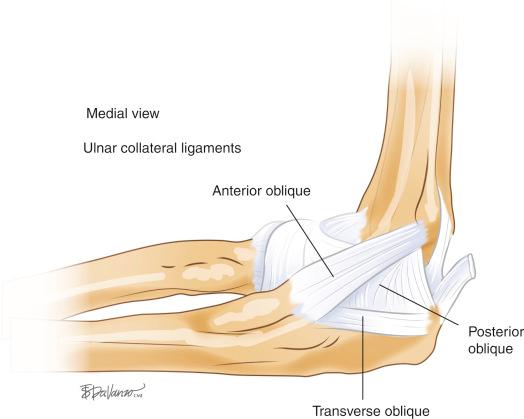
In addition to the MUCL complex, dynamic muscular support and the bony articulations of the posterior elbow compartment contribute to medial stability. The fibers of the flexor carpi ulnaris (FCU) are intimately attached to the origin of the medial epicondyle and optimally positioned directly in line with the MUCL for contractile support ( ). Cadaver biomechanical testing has demonstrated the FCU as the primary dynamic contributor to valgus stability in the elbow and the flexor digitorum superficialis as a secondary stabilizer ( ). Clinical electromyographic analysis has also demonstrated reduced forearm flexor muscle activity in pitchers with MUCL injuries, further suggesting the role of protective dynamic muscle activity ( ). The importance of the flexor-pronator mass is also appreciated by several authors, who advocate limiting dissection using muscle splitting techniques during MUCL reconstruction and recognize the importance of dynamic muscular rehabilitation during the postoperative period ( ).
The bony articulations of the posterior compartment share an intricate relationship with the soft tissues of the medial elbow. As the MUCL complex is stressed during valgus loading, the lateral radiocapitellar articulation undergoes compensatory compression. Biomechanical analysis has demonstrated that sequential partial resection of the posteromedial aspect of the olecranon results in a stepwise increase in elbow valgus angulation ( ). Therefore both the olecranon and the MUCL contribute to valgus stability. This has also been observed clinically, where 25% of professional baseball players who underwent olecranon debridement eventually required MUCL reconstruction in a large series ( ). Testing in the cadaver model has also shown that strain in the MUCL is increased with increasing posteromedial resection of the olecranon beyond 3 mm, further suggesting that aggressive olecranon debridement may place the MUCL at risk for future injury ( ).
The majority of MUCL injuries are the result of the cumulative valgus stress placed on the medial elbow during repetitive overhead throwing maneuvers ( ). Biomechanical studies have shown the valgus torque generated in the late cocking and acceleration phases of throwing can exceed 64 N-m and up to 60 N-m with a tennis serve, but the ultimate tensile strength of cadaveric MUCL specimens is only 33 N-m ( ). The repetitive near-tensile failure loads result in microtrauma to the anterior band of the MUCL, leading to attenuation and ultimately failure. When the forearm flexors are fatigued or injured, the elbow loses the dynamic muscular supports, placing additional stress on the MUCL. Therefore flexor-pronator conditioning is an essential component of MUCL injury prevention programs.
Although rare, MUCL injury can occur as a result of direct trauma in contact athletes.
A total of 10 MUCL injuries were documented in professional quarterbacks over a 14-year period in the National Football League (NFL), where 70% of injuries were the result of traumatic contact and only 20% associated with a throwing motion ( ). The nature of these acute traumatic MUCL tears was attributed to the high contact loads experienced at the elbow by football players as opposed to the chronic repetitive injuries seen in baseball pitchers. Fundamental differences also exist in the passing motion of football quarterbacks compared with baseball pitching because the increased weight of the football prevents the extreme angular velocities and torque across the elbow seen in pitching ( ). Kinematic testing has also demonstrated reduced rotational velocities over a narrower shoulder range of motion during the football pass, thereby reducing valgus stress on the medial elbow ( ).
A thorough history and physical examination are critical in evaluating MUCL injuries, as treatment recommendations rely heavily on a variety of patient- and injury-specific factors. Player age, type of sport, position, competitive level, future aspirations, willingness of the player to change sport or position, and perceptions of surgery should be considered ( ). Specifically for throwing athletes, any recent changes in throwing accuracy, velocity, and stamina before injury should be documented. The time of onset of symptoms in relation to ball release is also important because up to 85% of pitchers experience pain during the acceleration phase of throwing compared with fewer than 25% during the deceleration phase of throwing with MUCL injury ( ) ( Fig. 26A.2 ). Players may report a sudden event with sharp pain in the medial elbow accompanied with a “pop”; others may have a gradual progression of pain associated with changes in pitching speed and control. Duration of symptoms, prior episodes, and the exact location of the pain should be documented.
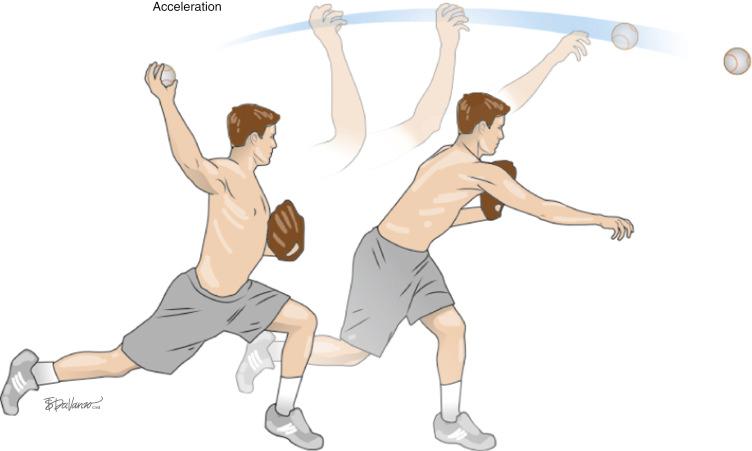
Injury risk factors should be assessed, such as a history of overuse (particularly in skeletally immature athletes), prior elbow surgery (arthroscopic posteromedial decompression), or change in pitching mechanics. Symptoms of valgus extension overload (VEO), including posteromedial elbow pain during either the acceleration phase or more commonly the deceleration phase of throwing, should be assessed because MUCL insufficiency may be overshadowed in these athletes. Limited extension and mechanical catching may also be present with VEO as a result of impinging osteophytes, chondromalacia, or loose bodies. Ulnar neuritis associated with MUCL insufficiency can manifest as paresthesia radiating from the elbow to the ring and small fingers. Cold intolerance, numbness or tingling in the hand, and difficulties with grip strength or dropping objects may also be present ( ).
Physical examination should include a detailed evaluation of the entire upper extremity and assess problems within the core and kinetic chain. Careful attention should be given to the ipsilateral shoulder as it is not uncommon for elbow and shoulder pathology to coincide in elite throwing athletes. The presence of a glenohumeral internal rotation deficit (GIRD) and reduced total rotational motion (TRM) have been identified as independent risk factors for MUCL injury ( ). The scapula should be assessed with respect to muscle tone and scapulothoracic rhythm because scapular dysfunction is often present in throwing athletes ( ). The presence of a flexion contracture with a lack of full elbow extension is also common in mature throwers and may be asymptomatic and should be compared with the contralateral limb.
The medial aspect of the elbow should be inspected for swelling and ecchymosis and palpated for tenderness along the course of the MUCL from its origin to insertion. Chronic tears may not have associated tenderness, and in acute tears, tenderness often abates with rest. Local MUCL tenderness should be distinguished from flexor-pronator injury. The absence of pain with resisted wrist flexion and pronation and the presence of pain posterior to the flexor-pronator origin can help to differentiate ( ). Ulnar nerve examination should include motor and sensory testing and provocative maneuvers such as the Tinel test for direct nerve irritation and dynamic instability with elbow motion. The presence of a palmaris longus tendon should be determined if MUCL reconstruction is anticipated.
Valgus instability is assessed with the elbow flexed between 20 and 30 degrees to unlock the olecranon from its fossa ( ). The valgus stress test may be performed with the patient upright or lying supine as the examiner applies a valgus force, attempting to elicit painful opening of the medial ulnohumeral joint. Isolated anterior band injury can produce opening at 30 to 40 degrees of elbow flexion, but a global MUCL injury may demonstrate opening at 80 to 90 degrees of flexion ( ). The milking maneuver is performed by the examiner pulling on the patient’s thumb to create valgus stress with the patient’s forearm supinated and elbow flexed beyond 90 degrees. A positive test result elicits pain, instability, and apprehension and indicates injury to the posterior band of the MUCL ( ). The moving valgus stress test is the most sensitive and specific for MUCL pathology and is performed by applying a valgus torque while the elbow is repeatedly flexed and extended ( ) ( Fig. 26A.3 ). The test result is considered positive if pain is reproduced at the MUCL and is usually maximal between 70 and 120 degrees of elbow flexion in an attempt to recreate the early acceleration and late cocking phases of throwing.
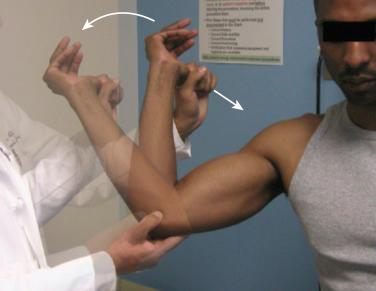
Standard anteroposterior, lateral, and oblique radiographs of the elbow are first obtained when evaluating for MUCL injury. In the presence of chronic injury, ossification along the path of the MUCL may be noted ( Fig. 26A.4 ). The presence of olecranon osteophytes, posteromedial joint space narrowing, and loose bodies suggest underlying VEO, arthritis, or both. Radiographs can also identify other abnormalities, including bone deficiencies at the sublime tubercle or medial epicondyle from prior fracture, altered epicondylar morphology, or enthesopathy at the sublime tubercle, each potentially influencing treatment and reconstruction technique ( ). Computed tomography with three-dimensional reconstruction can further delineate osseous pathology around the elbow and help plan for future osteophyte resection.
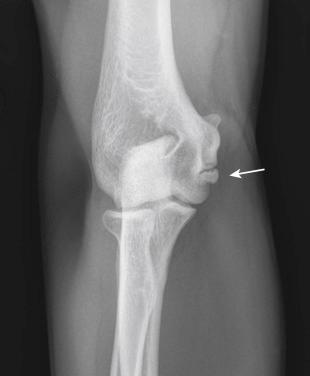
All patients with suggestive history and positive examination findings undergo MRI to characterize the MUCL. Conventional MRI studies are capable of identifying ligament thickening from chronic injury and large full-thickness tears. MR arthrography, enhanced with intraarticular gadolinium contrast, improves the diagnostic ability for partial-thickness tears ( ). Therefore when standard MRI is inconclusive, the preferred imaging modality is MR arthrography using a high-field closed magnet with narrow slice images ( Fig. 26A.5 ). The “T-sign” is seen where a pathologic volume of contrast dye leaks down along the sublime tubercle but is contained under the superficial fibers of a partially torn MUCL ( ). However, anatomical studies have characterized the insertion of the MUCL at 2.8 mm, on average, from the articular surface of the ulna, and thus some T-signs may be normal ( ). MRI can also identify concomitant edema and injury to the flexor-pronator origin as well as posteromedial ulnohumeral chondromalacia ( ).
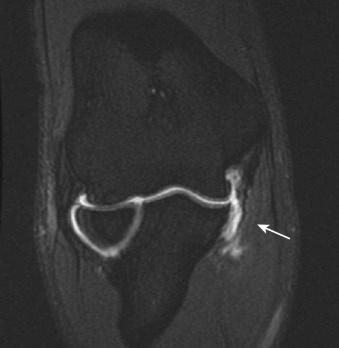
This chapter describes the surgical techniques and outcomes for posteromedial impingement of the elbow and elbow ulnar collateral ligament reconstruction.
Keywords: elbow arthroscopy, posteromedial impingement, UCL, ulnar collateral ligament
Elbow arthroscopy and a limited elbow arthrotomy can treat the pathology of posteromedial impingement seen in valgus extension overload.
The preferred technique is a supine-suspended elbow arthroscopy when treating isolated posteromedial impingement.
Portal placement is crucial to safe and efficient elbow arthroscopy.
When performed with a concomitant ulnar collateral ligament (UCL) reconstruction, a vertical arthrotomy is made posterior to the posterior band of the ligament to address posteromedial impingement.
Both arthroscopic and open decompression of posteromedial impingement have reported favorable results in the literature.
UCL reconstruction is a successful procedure to return overhead athletes to play.
The preferred technique is a modified Jobe technique.
The preferred graft is a palmaris longus autograft.
Transposition of the ulnar nerve is a crucial portion of the procedure.
Become a Clinical Tree membership for Full access and enjoy Unlimited articles
If you are a member. Log in here